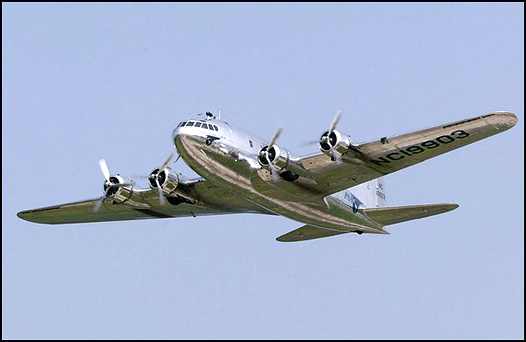![]()
![]()

Photo by Tracy A. Woodward / The Washington Post
A Boeing S-307 Stratoliner flies over the runway once before landing at Dulles International Airport. The plane will be put on display at the Steven F. Udvar–Hazy Center, the National Air and Space Museum’s new companion facility at Dulles Airport.
Thursday, August 7, 2003
For ‘Flying Cloud,’ a Momentous but Quiet Landing
Vintage Airliner Comes Home to Dulles
By Don Phillips
Washington Post Staff Writer
At a sunny 11:09 a.m. yesterday, chief pilot Richard “Buzz” Nelson killed the engines on Boeing’s oldest flyable airliner for the last time, transforming it from a living, roaring piece of history into a much anticipated museum piece.
The 63-year-old, four-engine Boeing S-307 Stratoliner touched down effortlessly at Dulles International Airport, in marked contrast to a flight last year when the plane crashed into a Seattle bay and had to be restored again.
Yesterday’s landing, which followed a goose bump-raising low flyover of Runway 19R at Dulles, was witnessed by a small contingent of Boeing employees, reporters, photographers and officials of the National Air and Space Museum’s Steven F. Udvar–Hazy Center. The plane was on the final leg of its journey from Seattle to the new museum at the airport, which is to open in December.
There was open sorrow that the big silver Clipper Flying Cloud would never fly again. The Smithsonian Institution has a policy against operating artifacts.
“It’s a sad moment, really, for me,” said Nelson, a longtime Boeing test pilot who is now chief pilot for the Boeing 767 program. “I believe an airliner like this should be flown. But I understand the risks, having been involved in a nasty accident.”
It was clear that Nelson did not consider yesterday’s flawless flight to be redemption for last year’s “nasty accident” — in which he ditched the Stratoliner in Elliott Bay after it ran out of fuel — even though Boeing officials made clear they had no qualms about trusting their valuable piece of history to him.
Wiping his eyes, Nelson said: “I’ve had a great career. I prided myself on being a safe pilot. I never had an incident like that before. I take full responsibility for that. I’m really grateful to Boeing for having enough confidence in me to let me fly this airplane.”
For Nelson, slightly younger than the plane itself, the Stratoliner was a family affair. His parents met when his father was a young aeronautical engineer responsible for designing the plane’s engine cowlings and his mother was secretary to Boeing’s chief engineer.
The Flying Cloud at Dulles is one of 10 that Boeing built and the only one remaining, although the fuselage of a Stratoliner originally bought by Howard Hughes, which he called his Flying Penthouse, is in use in Fort Lauderdale, Fla., as a houseboat.
As the first pressurized airliner, the piston-powered Stratoliner could fly as high as 20,000 feet, above a lot of bad weather.
The Clipper Flying
Cloud was built in 1940 for Pan American Airways and went into service
on a Brownsville, Tex., to Mexico City to Los Angeles run. More than 50
years later, a team of Boeing volunteers returned the plane to its original
appearance, inside and out.
Its interior smacks of an aviation era long gone, when passengers were
treated royally and had plenty of legroom. The cabin has nine seats along
its left side and four compartments with six seats each — or four
beds each — along the right side. The placement of windows is different
on each side to fit the various configurations. The plane flew with a
crew of six: a pilot, co-pilot, flight engineer, navigator, radio operator
and steward.
“It flies like a 1940s vintage airplane,” Nelson said. “It’s a thrill. It’s a challenge compared to a modern airplane.”
The Stratoliner has no autopilot, not even an altitude-holding function. “The autopilot is right here,” Nelson said, holding out his hands.
The Flying Cloud and other Stratoliners were pressed into military service in World War II. After the war, Pan Am flew the Flying Cloud until retiring it in 1948, when it moved on to a succession of owners.
In 1954, it was bought by the Haitian air force and, in 1956, became the personal plane of Haitian dictator “Papa Doc” Duvalier. Asserting that he did not trust pilots or planes, Duvalier sold it a year later.
In 1969, the plane was purchased by Aviation Specialties Inc. of Mesa, Ariz., and was being converted into a water bomber to fight forest fires when it was spotted by a Smithsonian curator. The museum bought it but had no place to show it, so the plane was lent in 1972 to an air museum in Tucson.
By 1994, the Smithsonian was ready to reclaim its property and made arrangements with Boeing to restore it. A Boeing team made the plane temporarily airworthy, and a crew led by Nelson flew it to Seattle. The Flying Cloud was restored in the same building where it was built.
During test flights last year, the crew relied too much on the cockpit fuel gauge instead of measuring fuel with a dipstick, according to a National Transportation Safety Board investigation of the plane’s March 2002 accident.
Nelson ditched the plane in Elliott Bay just a few feet from a Coast Guard rescue station and in full view of diners at Salty’s Restaurant in West Seattle. The crew members walked onto the wing and then into a rescue boat without getting their feet wet.
The plane sank but experienced only minor damage and saltwater contamination; it was fully restored again in little more than a year.
Its last flight took it from Seattle to Great Falls, Mont., St. Cloud, Minn., and an air show at Oshkosh, Wis. On Tuesday, the crew headed for Dulles, pausing overnight in Pittsburgh to wait out bad weather.
As the Flying Cloud taxied yesterday to its temporary storage position behind the Air France Concorde, a Boeing employee pulled a reporter aside and said, “The museum may have the plane, but the heart and soul is ours.”
© 2003 The Washington Post Company





